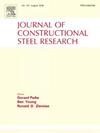Comparison of seismic resilience of steel frame structure equipped with double-stage and conventional buckling-restrained braces
IF 4
2区 工程技术
Q1 CONSTRUCTION & BUILDING TECHNOLOGY
引用次数: 0
Abstract
An asynchronized parallel double-stage buckling restrained brace (APDBRB) is proposed to overcome the limitations of buckling restrained brace (BRB), emphasizing the concurrent control of seismic responses and resilience of steel frames (SFs) under both the design basis earthquake (DBE) and maximum considered earthquake (MCE). To identify these advantages, one SF, one SF equipped with BRB (SFBRB), and 15 SFs equipped with APDBRB (SFAPDBRBs) were analyzed. Significant improvements in structural seismic performance and resilience were observed using APDBRB. (1) APDBRB reduced the repair time of SF from 45.39 to a minimum of 8.5 d under DBE and from 90.95 to a minimum of 25.4 d under MCE, while those of SFBRB reached 17.88 and 52.76 d under DBE and MCE, mostly due to the effective control of absolute floor acceleration (MAFA) under DBE and maximum inter-story drift ratio (MIDR) under MCE.(2) APDBRB reduced the restoration cost of SF by up to 81.20 % under DBE and 58.93 % under MCE, which were significantly better than those of BRB (50.74 % under DBE and 47.31 % under MCE), realized by the concurrent control of MIDR and MAFA. (3) BRB improved the resilience level of SF from 0 to 1, whereas the resilience levels of the well-designed SFAPDBRBs reached Level 2.
求助全文
约1分钟内获得全文
求助全文
来源期刊

Journal of Constructional Steel Research
工程技术-工程:土木
CiteScore
7.90
自引率
19.50%
发文量
550
审稿时长
46 days
期刊介绍:
The Journal of Constructional Steel Research provides an international forum for the presentation and discussion of the latest developments in structural steel research and their applications. It is aimed not only at researchers but also at those likely to be most affected by research results, i.e. designers and fabricators. Original papers of a high standard dealing with all aspects of steel research including theoretical and experimental research on elements, assemblages, connection and material properties are considered for publication.
 求助内容:
求助内容: 应助结果提醒方式:
应助结果提醒方式:


